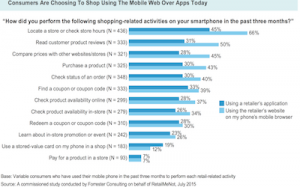
Ajay Kapur is founder/CEO of Moovweb
By Ajay Kapur
In the coming year, we will continue to see rapid growth of mobile commerce.
Here are three predictions that stand in contrast to the prevailing discussions around mobile payments, beacons, geo-targeting, Apple Passbook/Wallet and native applications.
1. The tail will wag the dog. In-store digital strategies that drive online sales will succeed. Those that attempt to drive in-store sales will fail
Consumer confidence has grown steadily since 2011, yet store foot traffic is declining, according to ShopperTrak.
Shoppers are going online. This is a tectonic shift in the way consumers prefer to shop and buy.
Mobile is at the epicenter of this transformation, disrupting the traditional divide between the physical and online worlds.
Retailers are betting that the mobile devices can draw more foot traffic and in-store sales through geo-targeting, beacons and other technologies. Those approaches are years away from mainstream adoption. Big bets in those areas will not meet expectations in 2016.
Savvy retailers are taking the opposite approach. They use their physical footprint as a vehicle to enhance the online and, increasingly, mobile shopping experience.
Same-day shipping and curbside pickup are two salient examples of enhancing the convenience of online shopping with the instant gratification of receiving your purchase within the day.
The left column in the chart below lists a set of strategies in which online sales are the primary goal. Retailers that pursue them aggressively in 2016 will see strong ROI and demonstrable increases in customer satisfaction.
The right column in the chart below lists the more traditional approach in which retailers attempt to augment the in-store experience and sales through technologies for which shoppers are not ready or interested.
 Moovweb chart on physical stores supporting online sales versus digital supporting physical store sales
Moovweb chart on physical stores supporting online sales versus digital supporting physical store sales
Takeaway: shoppers increasingly want to buy online, retailers can help make that experience even better through their physical stores.
Physical stores support online sales
Same-day shipping
Shoppers want their items immediately. Same-day shipping facilitates this with the convenience of online shopping.
Same-day delivery offerings are still relatively rare, with only 15 percent of retailers worldwide providing the service, but it is rapidly expanding.
Services such as Google Shopping Express, Amazon same-day and Postmates are becoming popular in some major cities. Amazon Prime Now is pushing further, offering two-hour delivery of thousands of items.
Curbside pickup
Curbside pickup is perhaps the clearest example of mobile blurring the online and offline worlds.
Target and Kroger recently rolled out curbside pickup services. Sears recently expanded its in-vehicle curb services to include returns and exchanges. Expect this trend to accelerate in 2016.
Online reservations
Online reservations/purchases of services, such as trying on clothes at Sears, changing tires at Pep Boys, dog grooming at Petco Unleashed or eye exams at Target allow retailers to bring the scale of online demand generation to in-store services.
Drop shops or guideshops
Bonobos and Indochino’s guideshops are stark examples of the tail wagging the dog.
Shoppers get a great, high-touch experience in a store and become loyal customers who buy online for years. Customers do not leave the stores with purchased items. They are shipped home through an online order.
Showrooming
Showrooming – when they visit physical stores to test and compare products with the intent of buying those products on their phones or online –is mainstream.
According to a 2014 Harris Poll, 46 percent of people do showrooming. Some retailers such as Target are embracing showrooming to drive sales. But as a strategy for retailers with physical stores, it represents a challenge.
Few online stores have the rich set of reviews and product comparisons that Amazon has and, as a result, showrooming tends to hurt most retailers and benefit Amazon.
Digital supports physical store sales
Store locators
Shoppers using their smartphones to look up store hours and locations is a mainstream activity, either via applications such as Google Maps or the retailer's mobile Web site. Few retailers have translated this mainstream activity into a richer experience once the shopper arrives at the store.
Beacon-based strategies
Per Retail TouchPoints, although 29 percent of retailers have implemented beacons in their stores, there is little shopper engagement through beacon-based offers and other in-store digital engagement strategies.
The problem is two-fold: shoppers do not have the retailer’s app installed and even for those few who do, there are no established patterns of consumer behavior around in-store digital engagement and offers. This will not tip in 2016.
Software vendors are selling a vision to retailers of collecting rich data about shopping behavior and new levels of in-store engagement. But shoppers are not there yet and may not get there for years.
Mobile payments such as Apple Pay and Android Pay
Mobile payments are slightly more convenient for shoppers than using a credit card. There is nothing about this added convenience that will materially drive more in-store sales.
Geo-fencing
The idea is simple. Retailers can draw more foot traffic by providing offers or other reminders to people who are nearby and who opted-in to receive such offers. Starbucks did this through its app and Apple Passbook.
While the vision is compelling, few people have retailers’ apps and fewer opt-in for these notifications. Consumers are not ready.
Another example is Neiman Marcus, which used geofencing to enable salespeople to see when VIP customers were in a store, look at their purchase history and provide more personalized service. But, the reality is this technology is still too slow to catch on with consumers.
Store associate app and sales checkout
These apps are designed to enable enhanced engagement between customers and sales associates. They also allow sales associates to provide real-time product, inventory availability and location information to customers based on historical patterns and profile data.
The key for retailers is developing these apps so that they expand the customer experience, while making it easy to use for the sales associates. The only retailers that have successfully weaved this into their retail strategy have been Apple and Nordstrom.
2.
The mobile Web will continue to outpace mobile apps for mobile commerce
Mobile apps represent a small fraction of the total mobile revenue for all but a handful of the biggest brands.
Amazon has more app revenue than mobile Web revenue. Walmart is getting close to parity. Most are not even close. Why?
Benedict Evans summed it up most succinctly: “Do people want to put your icon on their home screen?” The answer for most brands is ‘no.’”
Does this mean retailers should not create native mobile apps? Absolutely not. But the goals are different.
Apps are for retailers’ most loyal customers by definition. Who else will download your app?
So instead of a generic shopping app, consider a VIP program for your best customers, delivered through an app. This will not only drive more revenue from these customers, it will also make their experience better.
A recent Forrester Research report shows shoppers prefer to buy from mobile sites while on the go.
 Consumers are choosing to shop using the mobile Web over apps today
Consumers are choosing to shop using the mobile Web over apps today
The reality is that shoppers show up to your mobile site, not your app. Your mobile site is intimately connected with all of your marketing activities including email, search engine optimization and marketing and affiliates. Your app, even if the shopper has it, is not.
But what about data that shows more than 85 percent of mobile time is spent in apps? On the surface, this number would indicate that offering an app is an imperative.
But if you dig deeper, it becomes clear that a few apps dominate our time: Facebook, YouTube, games and music apps. In fact, 80 percent of consumers’ app time is spent in our top three apps, according to comScore.
The data is clear: apps are for fun, mobile Web is for getting things done.
This is why mobile Web represents the vast majority of mobile revenue for most retailers.
3.
Mobile Web checkout will be a big area of investment for retailers
Retailers are losing $18 billion annually due to shopping cart abandonment.
Research shows more than two out of three users who add items to their online shopping cart leave without making a purchase. The numbers are even worse on mobile where conversion rates are 70 percent lower than desktop.
This year was a pivotal year for mobile shopping. With more than 57 percent of online traffic and 30-plus percent of revenue, mobile dominated this holiday season.
It was a wake-up call for those brands that have not optimized their mobile experience, including the most critical part – the checkout journey.
The mobile checkout experience currently is miserable.
Baymard Institute, a leading ecommerce usability research firm, notes: “For the past three years, we’ve audited numerous multi-million and billion-dollar sites and during every single site audit, we’ve identified lingering technical errors, layout bugs or flawed interactive features.”
Mobile checkout can be made significantly easier.
Many brands will invest in radical improvements through payment options that accelerate checkout, and there are products focused on this problem.
With the rapid growth of mobile traffic and the incredible pain associated with buying on mobile, the key pages that represent the mobile Web checkout will soon be viewed as the most valuable pages on the Web.
WHILE IN RECENT years there has been a lot of noise around some mobile commerce technologies – for example, mobile payments, beacons, geo-targeting, Apple Passbook/Wallet and native apps – retailers would benefit from a simpler approach in 2016: increase online revenue by using their physical stores and improving their mobile Web experience.
This approach is not only easier to execute, it will yield better results, and retailers’ customers will notice.
Ajay Kapur is founder/CEO of Moovweb, San Francisco. Reach him at [email protected].
 Ajay Kapur is founder/CEO of Moovweb
Ajay Kapur is founder/CEO of Moovweb
 Moovweb chart on physical stores supporting online sales versus digital supporting physical store sales
Moovweb chart on physical stores supporting online sales versus digital supporting physical store sales Consumers are choosing to shop using the mobile Web over apps today
Consumers are choosing to shop using the mobile Web over apps today